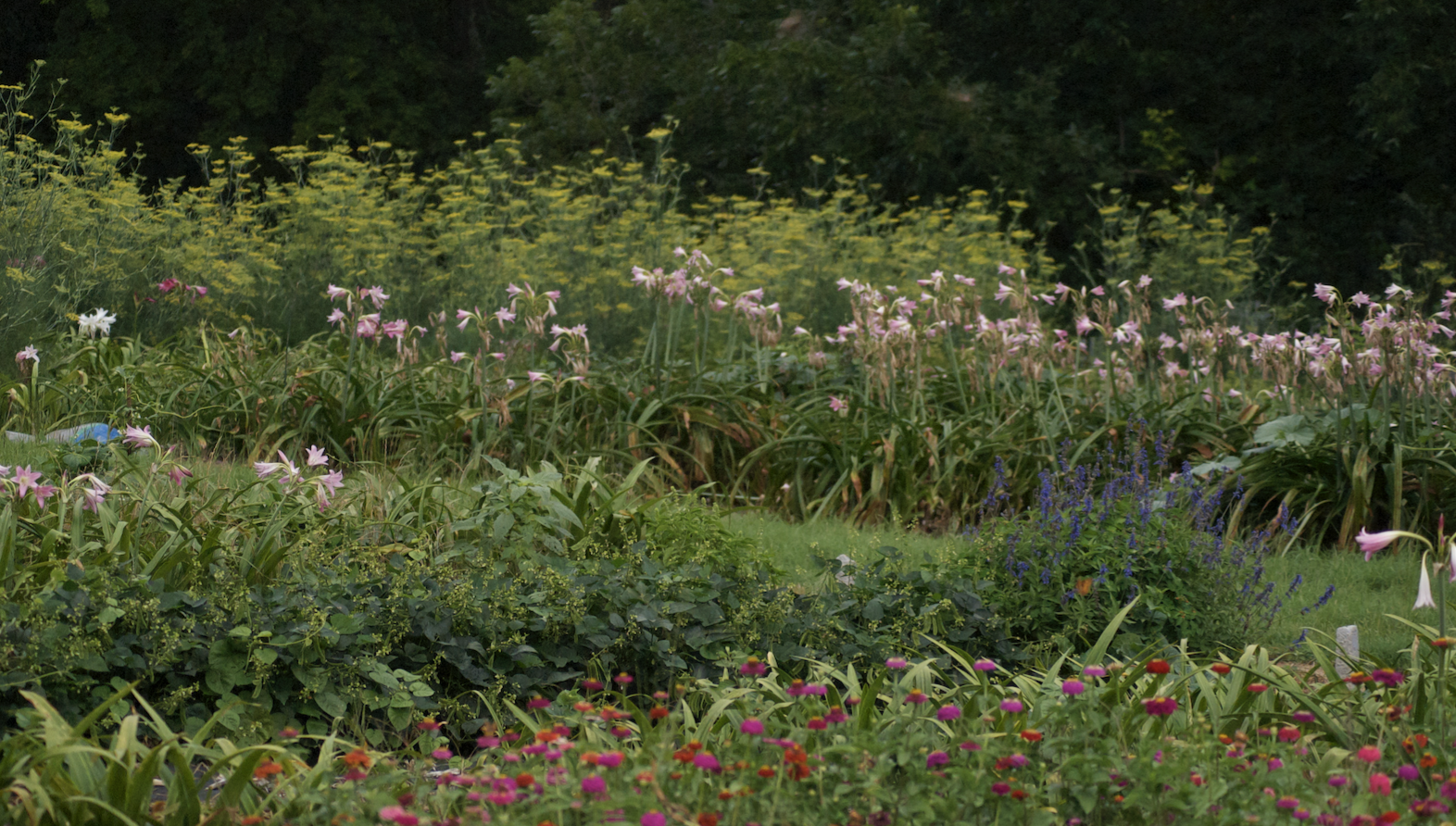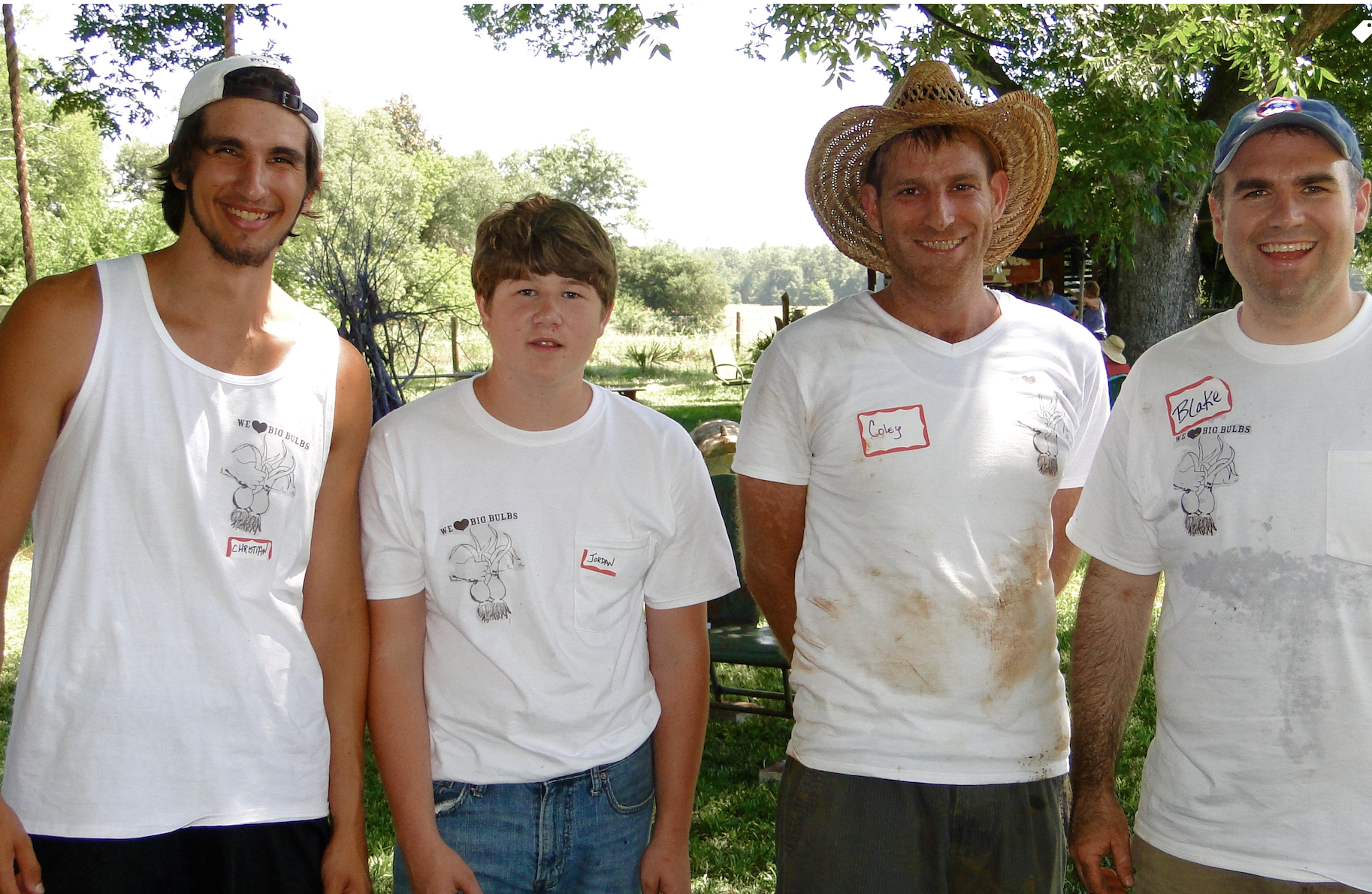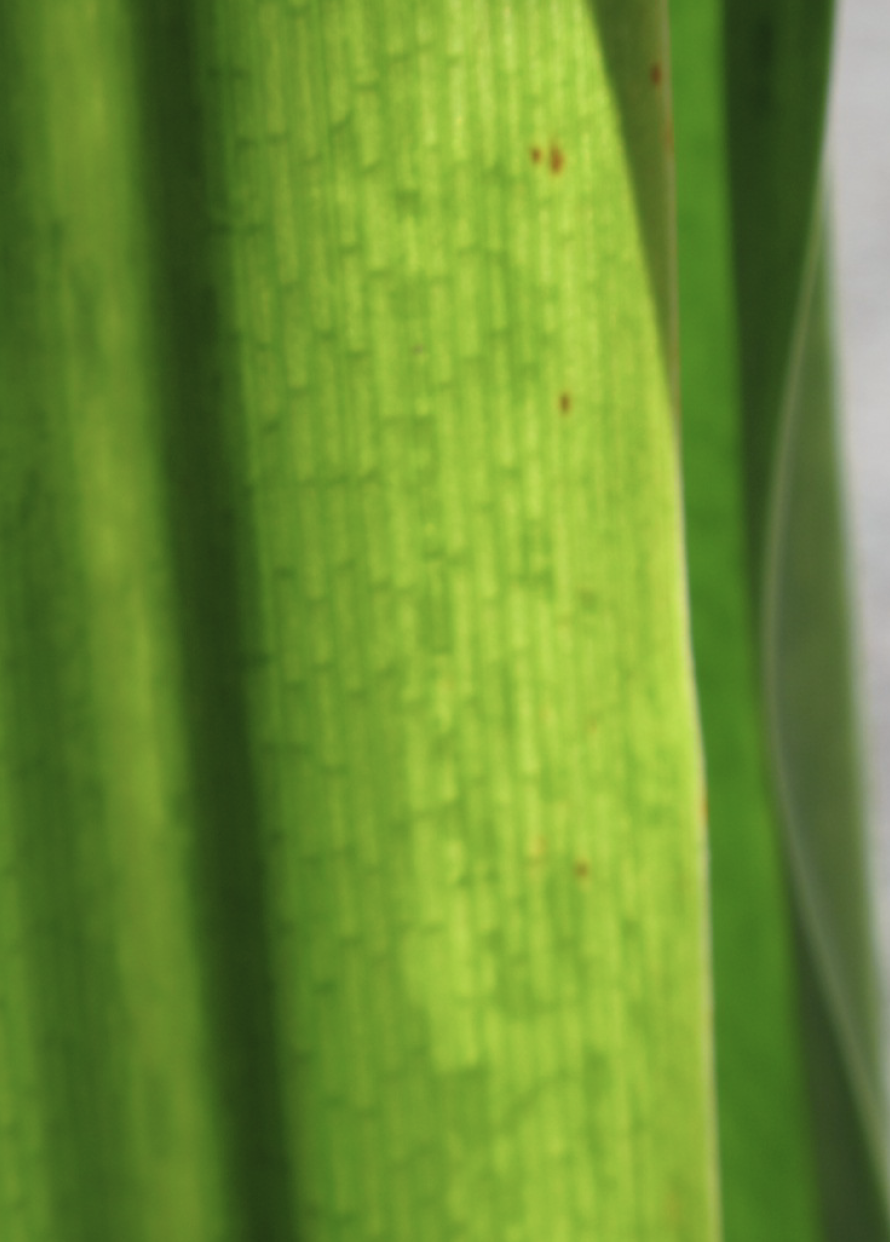
Virus Prevention on a Lily Farm. It’s a Community Thing.
Imagine endless rows of fields of corn on a modern farm. Now let the rows turn into endless pink flowers. Sounds pretty right? On our little farm, which specializes in one type of lily, we could grow that way. But like the small farms that sustained and built this country, here, diversity is key. Diversity builds strength, builds our soil, attracts pollinators and protects our crop from the ravages of one pest that might rampage through a uniform field of plants.
Early on this farm was diverse but by the 60’s it became a monoculture of corn and soybeans. In the 70’s, Daddy brought back some diversity. In the 90’s, Tom and I totally shook it up changing all rows to alternating vegetables and flowers. Still, with our monoculture farm neighbors, we share one never ending fear of rampant pest infestation.
Deer could mow it all to the ground. Grasshopper swarms could make it all ugly as sin. But we can see those. We can address them as a problem that occurs from the outside. What rattles me to the bone remains unseen. It’s able to sneak in on someone’s shoe. We’re constantly suspicious. On guard. No hugs today. Pull up your mask please. No, please don’t bring me that plant you dug up along the roadside. I’m on constant alert for the Trojan horse.
I wish it had a threatening name that brought Edgar Allen Poe writing ghost stories by candle light to mind. Hark! But no, what we fear seems named for childhood training pants; the dreaded Potyvirus.
Poty-virus. Well poop. Potyvirus could shut our business down. Worse, we could unwittingly ship out to customers.
Yes Poty Virus. Potyvirus could put me out of business. From day one, we had a plan to prevent, contain and protect ourselves from Potyvirus otherwise known a Crinum Mosaic Virus (CrMV).
Now imagine again those endless rows of lilies. But imagine the rich green leaves turned to the colors of a can of Mellow Yellow. Dark greens spots mix with acid yellow blocks, pixelated, like a bad phone photo. That is what mosaic virus does to leaves. What it does to the plant is worse; it gets into the DNA of each cell. There is no cure.

Here’s a picture of Watermelon Potyvirus from National Center for Biotech Information
For the Good of the Community
Like it’s more common cousins, tobacco mosaic or cauliflower mosaic, CrMV usually doesn’t kill a bulb. It just makes the leaves all yellowish. In fact, if you add lots of fertilizer, even a bulb with the virus can look just fine. It’s called masking — over fertilizing to hide the symptoms. I guess you could call it asymptomatic.
But that bulb can still transmit a virus.
If I sold you a sick bulb, but a fertilizer pumped-up bulb, you may not see the problem for a year. You’d plant it and coddle it and love it. But then on your amaryllis or maybe some other kind of bulbs that you love or on that crinum lily that great, great aunt Josephine carried in her bag from Trinidad to New Orleans to Texas and passed down to every woman in your family line, you’d notice weird leaves. And in a few years, your bulb and your newly infected bulbs would start to wither and waste away.
You could do the same thing if you dug up some daffodil bulbs in an old garden and gave some to a friend who collects daffodils. Daffodils get potyvirus too, a different one, but it creates an equally potty situation. You’ve read enough gardening books to understand how weeds, seeds, or potty viruses get passed around and spread through a population.
Protecting our lily farm therefore protects you and your friends from potyvirus. You’re welcome. But there’s another group of people who’d feel the impact if we hadn’t set up a virus protection regime years ago.
My family for starters. Tom and my Mom who love to see the farm thriving. Employees too. The teenagers who work here in the summer, college interns, full-timers. They get pay, experiences, social security contributions from the farm. On top of that, we pay sub contractors like electricians, graphic designers, web designers, book publishers and the occasional cartoonist.
Visitors come from all over the south, down this little dirt road, to enjoy the place and to shop. To learn about our plants and farm stewardship. They buy gas. They buy tickets and books and t-shirts at the state park down the dirt road. Small businesses like this little farm make up about half of jobs and the of the US economy (the % is constantly argued and in flux). That invisible little virus would definitely impact the economy of more than a few people around here.
These days, since we can no longer have on-farm tour groups, we have an on-line facebook class every Saturday. We do little plant sales and fund raisers for the garden club. This little farm is still a gathering place in a way, a part of the reality of what community means today. If we ignore prevention of the potyvirus, we all lose.
Established from Start Up
When we started back in 1993, we were one of the first nurseries selling on the web. Once when AOL was dial up only, we were featured on the AOL homepage. That was before homepage was a word. We got mail! And orders. And we went full into the digital world. Who could have dreamed then that we’d need to develop a youtube channel? There are things a business can’t anticipate. Rolling with the punches pays off sometimes.
But good farm practices like virus prevention stay constant and get regular updates.
Our plan included prevention first. New plants from unknown sources were inspected to the best of our ability. New plants get planted away from the field. Sometimes off site.
It’s sort of like importing plants. We have a license to collect and import plants from other countries. In those cases, plants get inspected by Federal scientists before we’re allowed to ship them in.
When I go to a nursery or crinum breeder, I get to inspect the plants. When I poke around and collect plants in old cemeteries or home sites, or in one now famous case, old discotheques, I not only inspect but quarantine those plants before they come into the farm.
We have other inspectors too. Annually, scientist from the Department of Plant Health visit. Normally, it’s just once a year. But in 2019, four of them came. We have a private consultant, a pathologist who understands our situation walk through too.
That’s all about detection. Realizing if and when there is a threat and coming up with a plan to contain it. During the decades of our business, no virus has ever gotten that far. A noxious, invasive weed has though, so while it’s much less of a risk, we have had one area put under quarantine and those government scientists wrote and installed a plan, a binding contract for us to manage the problem. That’s their job. You and I pay them through taxes, just like we pay meat plant inspectors and water chemist and spinach monitors to prevent widespread food poisoning.
Detection is protection. But hands on, daily farm practices protect too. At a central point, we have three giant stainless steel sinks. Bleach water and soap almost always fills one sink. All good horticulturalists know to clean tools with bleach. We clean our shovels and machetes. It’s not rocket science. But it is science. Or behavior based on basic science. Behavior based on science keeps us in business.
In one of those sinks, we bathe all bulbs leaving the farm. They get a mix of soap and bleach and drying as outlined in The Physiology of Flower Bulbs by Dr. August Dehartog, who basically started the forced bulb industry in the United States. We clean all the bulbs going out. Cleaning outgoing bulbs is not for us. It’s for your protection. Science keeps your garden healthy.
There’s one final step. It’s a long term thing. We keep great records. Last week, someone contacted me to see if I would share with them a rather rare bulb, a variety called ‘International.’ For the life of me, I couldn’t recall ever growing it. But a quick database check told me that I got it in from a specific nursery in 1995. I grew it out in Columbia, decided it looked suspicious and got rid of it with in the year.
Just last week, a director of a botanical garden up north told me that something I sent him looked like it had a virus. I’ve thoroughly inspected my plants now. I see no sign of virus here. But just to be sure, I’ve dug up some of them, isolated them in a pot and plan to starve them, to make them go into fertilizer stress which will reveal any weak or hidden virus.
I’ve also called on other professionals to see if they see any sign of virus. If so, that indicates spread from here which means I may have to get rid of an entire row. It’s like contact tracing. It’s a lot of work but it saves plant lives.
It’s a Passion
Felder Rushing, a recently retired scientist from Mississippi State extension, is a master at cutting to the chase and putting complex science in succinct easy to understand terms. Felder coined the term slow gardening and made famous pass-along-plants; both terms that convey a world of information. Felder told me once that this business was so much more than income. “It’s your passion. The plant you’re passionate about multiplies so you have to sell some, so that you have room to keep growing more!”
For a moment, I was offended because I thought he was saying this farm wasn’t a real business. Now I get it, I’m proud of it, I revel in the fact that I’ve been lucky enough to spend my life doing what I love; designing gardens, growing great plants and helping other people get them, grow them and share them. And it’s all been done with an understanding of science that keeps me and other people healthy and happy. Imagine that. 




It’s scary – the responsibility. Yours and ours! We’re proud of your work, as I know y’all are.
Wow, Jenks that was beautiful! My master’s degree is in plant virus and I did research on a different potyvirus, Cymbidium Mosaic Virus and its transmission by Australian cockroach. You are wise to be so diligent. My work demonstrated that a virus that is typically transmitted by mechanical means can be transmitted by a chewing insect.
Someday, I hope to come down that dirt road and visit you. For now, I enjoy your Facebook transmissions.
Stay safe!
I think the fact that it’s mechanical transmission helps us a lot. If I do bring some in, unless there’s a huge swarm of transmitting insects, that one bad plant is fairly isolated. Thanks Carol, sometimes it feels like making a mountain out of mole hill.
Very interesting! I’ve been privileged to see some of these preventative measures in action at the Lily Farm. Anyone purchasing plants from the Lily Farm can trust that, not only will their plants be beautiful, they are also healthy and safe.
… so much to learn and think about ….thank you for opening our eyes to this and making us all more aware… I will be more diligent with cleaning the garden tools going forward and more observant of how my plants are behaving…. and thank you for taking such very good care of the farm, a very precious place on this earth ……stay well and safe …..
Hope you can help me with my crinum lilies. Every spring when the new leaves show up, they’re all stuck together. I pull them apart leaving brown tips all summer long. See no bugs but sort of like spider webs.
Just cut it in the spring! It’s just old leave goop.